
At 9:50 AM in the morning we arrived at Jingdezhen as per the same train we had boarded yesterday however much we had wished something else. We arrived straight from the north after an extraordinarily tiring journey. On the platform meeting us as promised by Dr. Liu were a friendly group of his assistants. We were offered and accepted most gratefully a ride with their small modern bus that took us to our familiar favorite hangout in Jingdezhen, the small and comfortable Jingdezhen Hotel Guest House.

Jingdezhen Hotel Guest House, view from the room towards the city.
In the far distance the sight of two kiln chimneys made me smile with anticipation.
Photo by Jan-Erik Nilsson, Monday 7 September 1992.
Had lunch, slept to 3 PM, went out. It was raining, not much of a breeze. The tropical sounds, the large white birds looking strangely out of place in the lush trees surrounding the parking lot outside of the hotel, and the visions, were mesmerizing. I had so much wanted to come back to this place that I could 'feel the taste of it'.
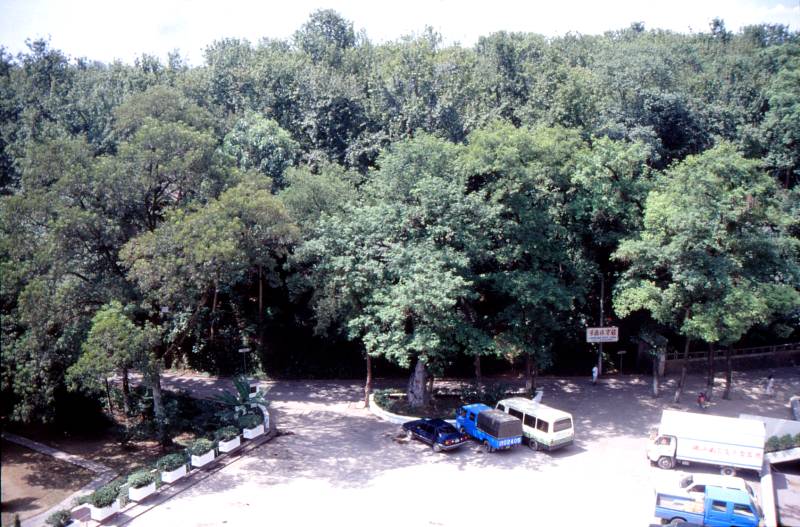
Jingdezhen Hotel Parking lot. 7 September 1992
I insert here a summary of the dynasties and imperial periods we talked about the most.
Five dynasties 907-960
Song
Northern Song (Bei Song) 960-1126
Southern Song (Nan Song) 1127-1279
Jin 1115-1234
Yuan 1279-1368
Ming 1368 - 1644
Hongwu (1368-98)
Jianwen (1399-1402)
Yongle (1403-25)
Xuande (1426-35)
Interregnum: Ming Mid-15th Century
Zhengtong (1436-49)
Jingtai (1450-57)
Tianshun (1457-64)
Chenghua (1465-87)
Hongzhi (1488-1505)
Zhengde (1506-21)
JiaJing (1522-66)
Longqing (1567-72)
Wanli (1573-1620)
Tianqi (1621-27)
Chongzhen (1628-44)

Fig 1. In a painters pavilion within the Ancient Porcelain Exhibition District, Banlong Ridge, in Jingdezhen, we found this painting depicting the Imperial Porcelain factory with its original Longzhu (dragon's pearl) pavilion shown in the top center. (Click to enlarge).
Photo © Jan-Erik Nilsson, Jingdezhen 7 Sept 1992.
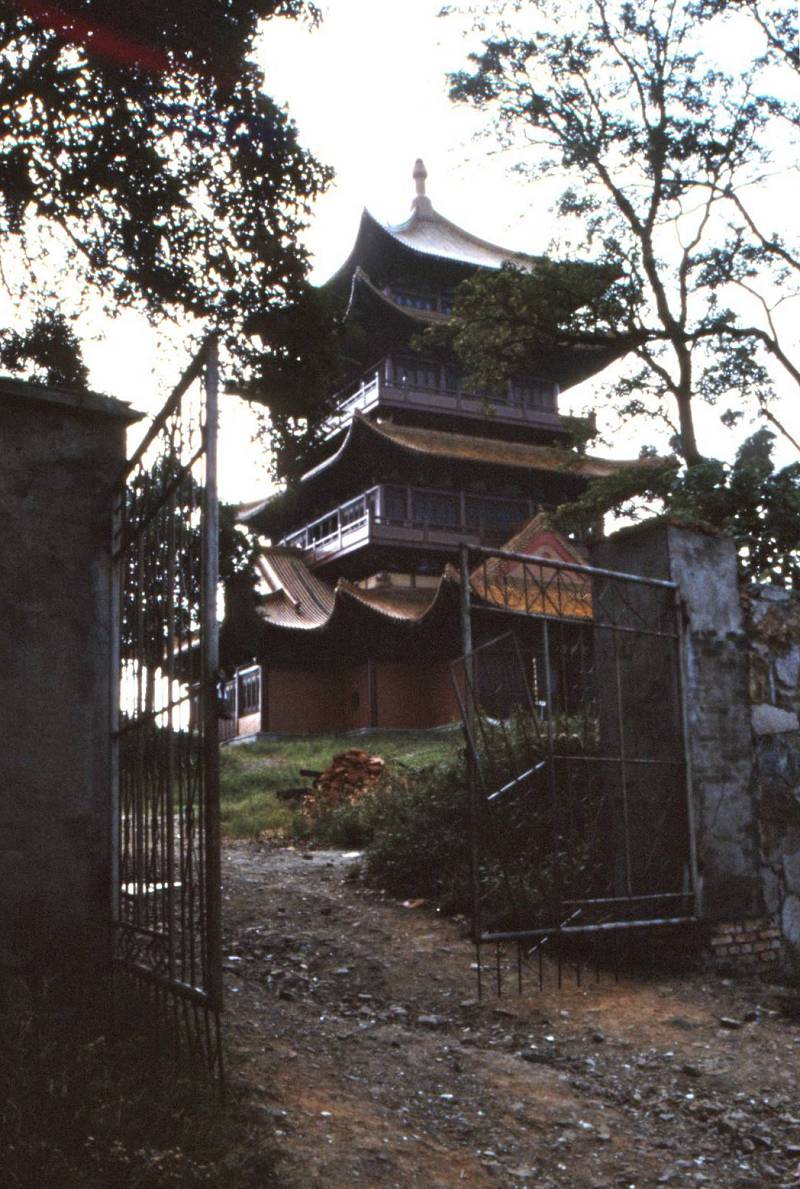
Longzhu (Dragon's Pearl) pavilion, a fairly newly renovated building on the Pearl Hill Zhushan,
which is the highest point in the old area of the Imperial Porcelain Factory.
Our first goal was the Longzhu (Dragon's Pearl) Pavilion, a fairly new building on Zhushan or, the Pearl Hill, which is the highest point in the old area of the Imperial Porcelain Factory. The history of this pavilion goes back to the Tang dynasty but it has been renovated and rebuilt a number of times. Each time probably on top of the rubble from its predecessors. At one time Dr. Liu pointed straight down and said that 'Chenghua is nine meters down right here'.
The old factory site is now a messy neighborhood with low brick pavilions of varying age, appearance and content. "Offices and homes", Dr. Liu says about it in his introduction to his catalog of Yongle (1403-25) and Xuande (1426-35) period porcelain excavated in the area.
In the first large entrance hall of the pavilion is a grand fantasy model of the "factory" surrounded by four splendid porcelain objects. In Europe they had been insured for millions, but here in this hall, they look perfectly at home and seem to be completely safe, firmly united with its improbable surroundings and its millenary history.
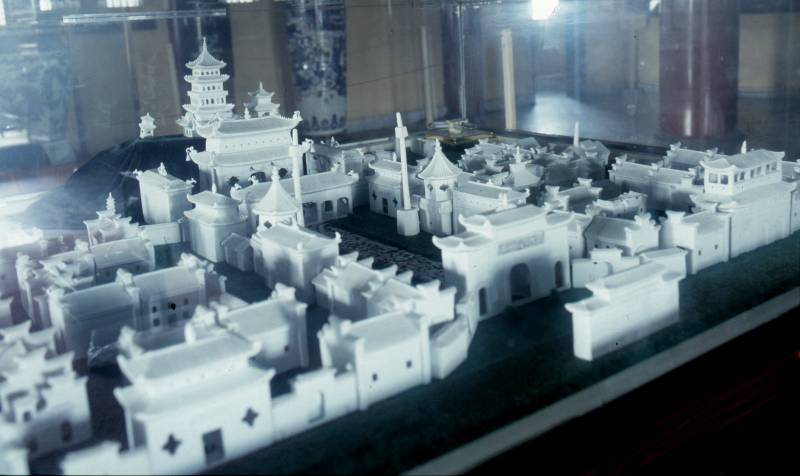
Fantasy model of the Imperial Porcelain Factory, Longzhu pavilion, September 1992
The items are first of all a jar of the Xuande (1426-35) mark and period as well as a fish jar of lotus pod shape which they say is from Zhengtong (1436-49) but that looks like Xuande. It is 88 cm (35 inch) in diameter and 70 cm (27.5 inch) high. They have not yet found any historical documents that tell how many pots like this were manufactured. They have however found fragments from about 20 pieces and there is nothing that says that any one was ever successful. The problem lay in the mold they say, the pot was turned in parts and it was too difficult to join them. Documentation is available in Foliang County Chronicles; Ceramic document of Jingdezhen.
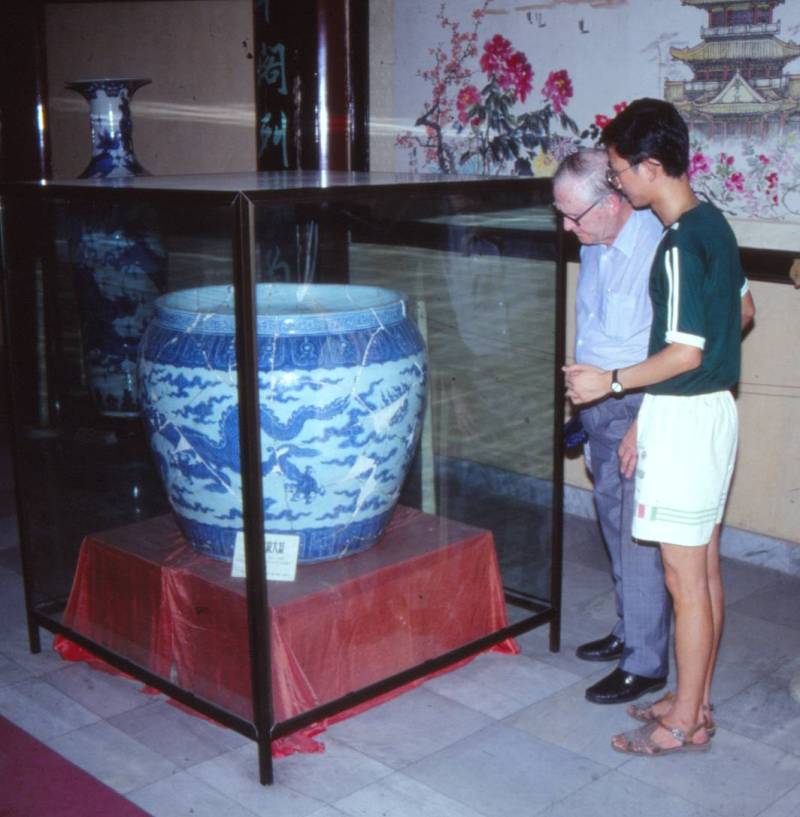
Zhengtong (1436-49) jar, probably to keep water for fire hazards which was a perpetual problem since the Imperial palaces was supposed to be the highest building in the environment and thus attracted lighting strikes at any one thunderstorm.
On the top floor we have a sweeping view of Zhushan and Jingdezhen towards the south. In the far distance is the Nanshan, the South Mountains, to all practical purposes, a gigantic shard heap from the Song dynasty.

View of Jingdezhen from the top of Zhushan looking south from the highest point of the former Imperial porcelain factory site.
The area was wedge shaped with the narrow short end at the pavilion where we stand now, which was the highest point, widening downwards to have the mid point and main entrance where the red flag is.
From what we know of the architecture and logistics of ancient porcelain factories, the Imperial own kilns, to the extent there were any on this area, would probably be straight ahead of us, on the slope below the pavilion. From here and down to the red flag would probably be a central axis as is the case with most Chinese Imperial sites. Next, near or below the kilns, would probably be the decoration pavilions, facing south to benefit from the sunlight.
Further down as far as the area goes to the left of the flag, would probably be the location of the the clay preparation house for final washing and mixing etc. From there and upwards in pavilions facing towards us, would probably be the locations of the shaping studios, facing north towards us here, to facilitate the safe drying of the porcelain.
This would be the logic of it all but if it was ever like that I need to leave to future excavation to tell.
Where the administration buildings or even the supervisor of the Imperial factory might have lived is of course any ones guess. Personally I would have guessed to the right of the main entrance, seen from here, closer to the river. This is incidentally also exactly where Dr Liu and his Archeological Research Institute had holed up in a perfectly magnificent Ming building, built in the 6th year of the Chenghua period, called Pintao zhai (Xiangji long (lane) minzhai) last time we were here. It basically reeks of porcelain history and if Tang Ying have not been there personally, I'd eat my hat. However, I have no more information on it.
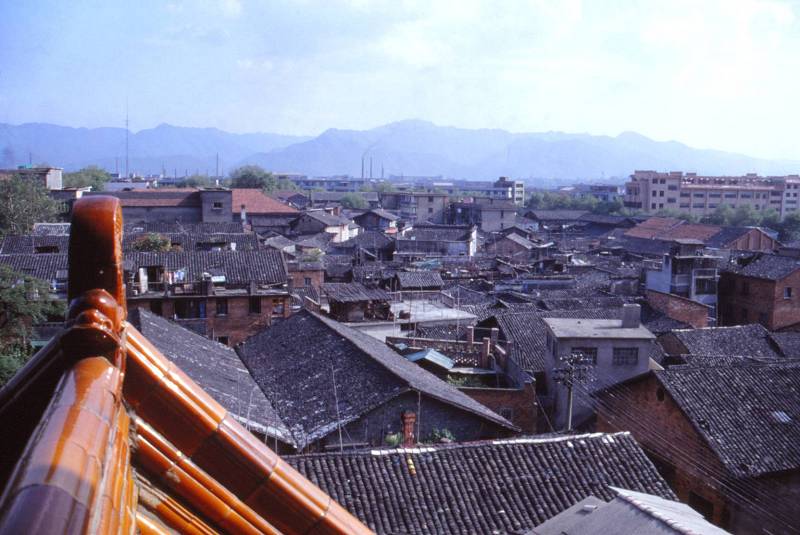
View of Jingdezhen from the top of Zhushan at the highest point of the former Imperial porcelain factory.
The left side of this picture is the former Imperial kiln area.

View towards the river Nanhe over Jingdezhen, from the top of Zhushan at the highest point of the former Imperial porcelain factory.
There are a large number of glass cabinets. One contains white porcelain from Yongle (1403-25). Among other items a white Buddhist washing vessel resembling a flagon, on a separate stand. Bo comment that Yongle was taken in by Buddhism in old age. White was the color of mourning. Had two to grieve. He was brought up at a Mongolian court and was accustomed to the significance of white.

White porcelain from Yongle (1403-25). Top left a white Buddhists washing vessel - a Kendi or 'kundica' - with a separate stand.
Here are also exhibited:
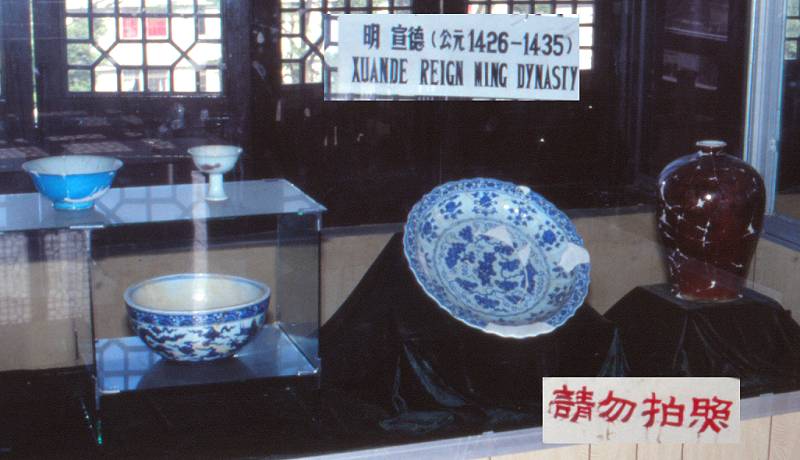
Blue and white, red and turquoise porcelain from Xuande (1426-35).
Margaret Medley says in one of her books that Zhengtong are unmarked Xuande, but according to the archaeologists we are talking to here, this is wrong. It is felt that there are plenty of items from Zhengtong (1436-49) and that there are several differences between Zhengtong and Xuande.
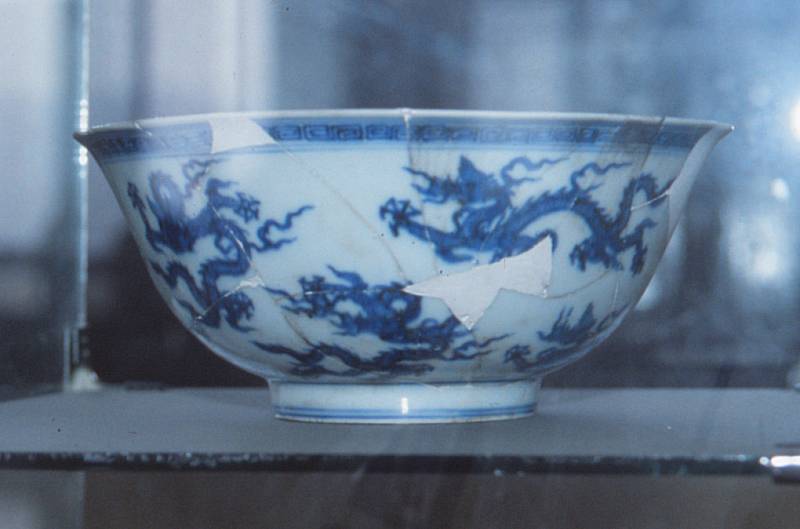
Zhengtong period bowl with sanscrit characters
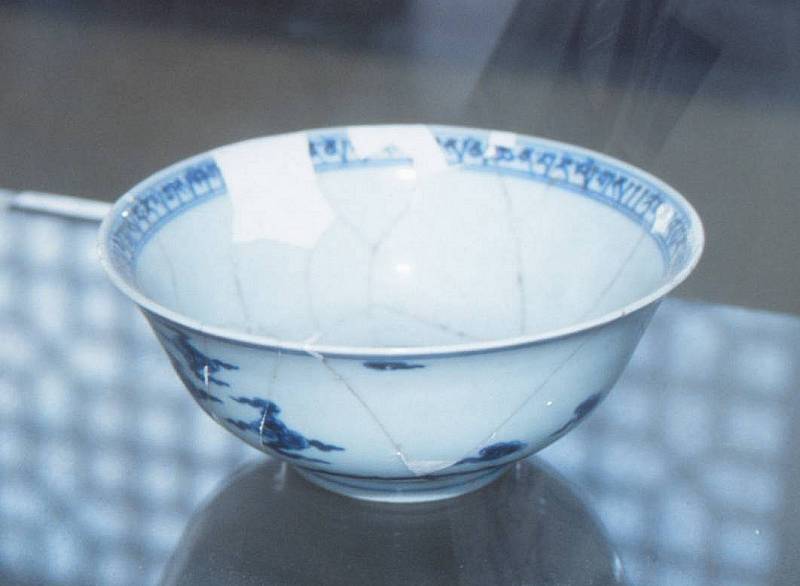
They mention that the shapes becomes more elegant and there are new decorations introduces, one of these is the decoration "seawater", a dense wave pattern. Another is Sanskrit-inscriptions. The decoration during the Xuande (1426-35) are more scattered. Generally speaking, the decoration becomes more compact, more dense, they say. There is little difference in terms of goods and glaze but the glaze contains more calcium.
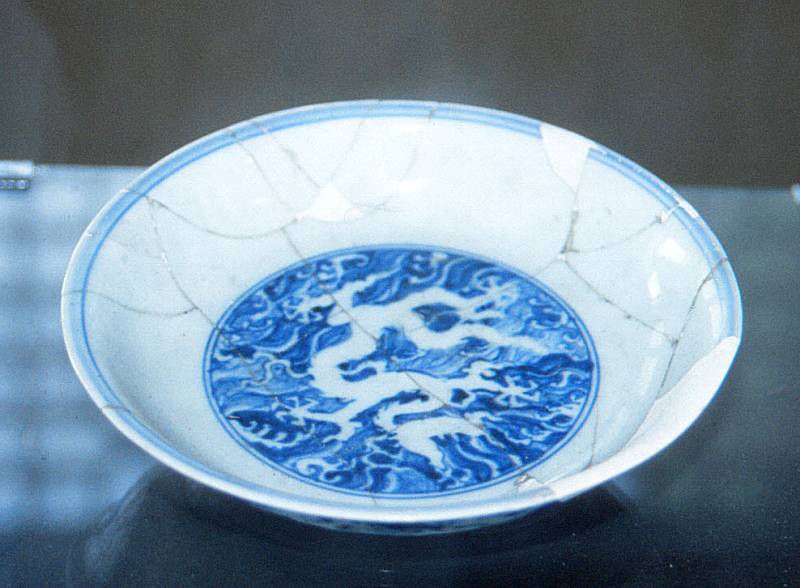
Low dish with a white dragon against blue background, on a high rounded foot ring
Among other things, we saw a low dish with a white dragon against blue background, on a high rounded foot ring. The information we are getting here, if it is correct, is sensational. One of the major issues concerning early Ming porcelain have been specifically about this interregnum period (1435-64). The question has among other things been if they continued to use the Xuande (1426-35) mark into the interregnum period and about what in that case was made. Here they are telling us with a shrug that perhaps half of all accepted Xuande (1426-35) mark-and-period pieces are excellent, typical and easily recognized examples of Zhengtong (1436-49). In particular this revaluation of interregnum is a major keepsake from this journey.
As to differences in decor, for example, the two upper of the four Xuande stem cups that are depicted on plate 10 in Brankstones, Early Ming Wares of Jingdezhen, could be Zhengtong. The same would apply to illustration XXI aa. Remarkably enough, even a stemcup Figure 53 in Dr. Liu's catalog aa. which is classified as Xuande mark and period, should then actually be a typical Zhengtong (1436-49).
According to my notes as for further differences, they say that the body is thinner than during the Chenghua (1465-87). This has been accepted in the case of the T'o tai, bodiless, wares of the Yongle (1403-25) but has never been mentioned when discussing the interregnum.
The exhibition includes also a lot of polychrome wares from Chenghua (1465-87).
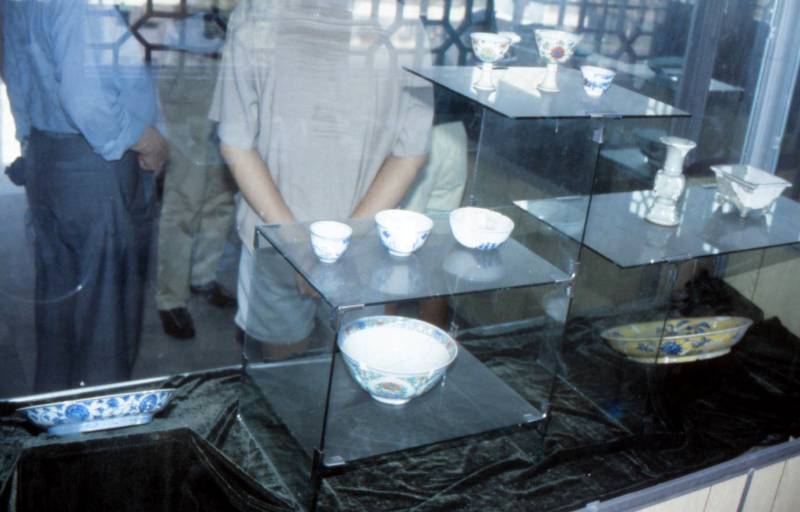
The exhibition also includes a lot of polychrome wares from Chenghua (1465-87)
Cabinet 1 contained white goods that were said to have been burnt in gourd kilns. White, is however a relative term, something we often came back to.
In another cabinet there was a series of small, white and warped object, Shu fu wares they said, and told that Shu fu was for official persons tomb use, made at the same or substantially the same kilns and during the same period. The pieces however contradicted the looks as well as the established definition of Shu fu, as - a particular ware with straight foot and light tapering shape, impressed characters Shu fu or the like, ordered through a special decision board, impressed decoration, glaze hanging as "tear drops" - and so on. This we'll need to follow up.